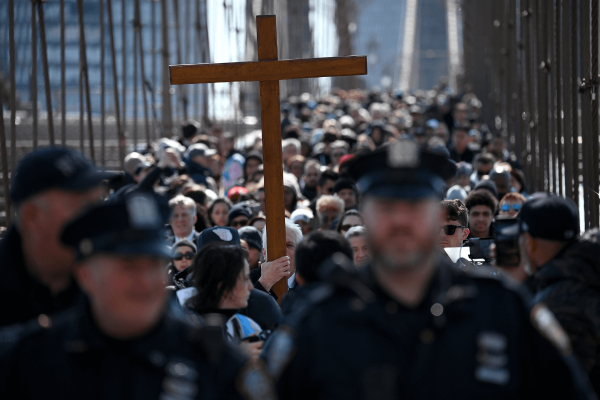The Rev. Liz Tichenor wrote the blessing and renaming ceremony described in the June issue of Sojourners. Samson is my 10-year-old transgender son. In this ceremony, together as a community, we affirmed Samson as a beloved child of God and recognized his new name.
This blessing, the first of its kind, was a huge part of him becoming strong and proud in his identity. It was an example of welcome that was transformative for my family, and for our church.
In my article, I didn’t address some of the theology and process behind this renaming ceremony from the perspective of the clergy person who went through this process with my family, and who made something beautiful happen. I wanted to share more of her thoughts here.
Today, Liz is wearing a hoodie over her clergy shirt and collar and drinking a latte in her sunny office. Before we begin, I tell her I didn’t send her the questions ahead of time because I didn’t want her to think about her answers. She laughs.
Here we go:
Dani Gabriel, writer, “A Blessing for My Transgender Son:” Why is a blessing for a transgender child important?
Rev. Liz Tichenor, Associate Rector, All Souls Parish: I think being known and seen in community is crucial. We experience being known in many different ways: in baptism, whether as infants or children or adults, in confirmations, in ordinations, in weddings. We haven't had anything for people who have transitioned to change their name or ask that we use different pronouns for them. Yet this is obviously a really profound shift in who they understand themselves to be. It’s important for the church to affirm that identity, and name it as good.
It is critically important that we be doing this now, because transgender people and folks who are non-binary or gender-fluid are under attack. Kids and youth are especially vulnerable. Because of this, it is all the more important that we offer another way in the Episcopal Church, a way of giving thanks and welcome and blessing to these wonderful folks who are in our midst.
Gabriel: So why did you, Rev. Liz Tichenor, do this blessing?
Tichenor: Because I'm Sam's priest.
I'd known Sam for about seven years when he came to me and trusted me with his evolving sense of self. I remember when he first came and said he wanted to be known as Iz rather than Isabel. “Okay,” I said. And then he told us that he wanted to use they/them pronouns. Again, “Okay, we can do this.” It felt like a real privilege that he was asking me to know him more fully, as he was coming to know himself more fully. When he came to me last summer and said “I want to be re-baptized,” there was no question in my mind that I would do something to honor the spirit of that request, even though we don’t re-baptize people. It seemed very simple, I guess. This is what he needed, and this is what I was called to do, as his priest.
Gabriel: What were you afraid of, in doing this blessing?
Tichenor: Honestly, on that Sunday, I was afraid for our collective safety. I did not want to show that fear, or say that to you or Sam or the other folks gathering… but this blessing had been out on the internet. It was not a secret that we were doing this. I just didn't know what would happen, and I felt like as the one leading the rite it was my responsibility consider all those possible permutations. Where are the different doors where somebody could come in? What would I do?
Gabriel: How did you choose the form?
Tichenor: We were clear that we did not want to send the message that we were re-baptizing him. We wanted to be very clear that when he was baptized as a baby, God knew him. No changes in how we understand or name or express ourselves can negate that presence. This was something different.
Time was of the essence. It was important that we do this renaming rite on the Sunday immediately following Sam’s court date to legally change his name and gender. Too often the church has said, “Yes, we support you, but it’s not quite the right time” or “Yes, we're moving in that direction, but you need to be patient.” The call for patience is all too often a veiled call for continued complicity with oppression. This was not the time for patience, but it was important that we do it carefully and thoughtfully.
What that meant liturgically is that it needed to be a rite that I as a priest could offer, rather than one that the bishop would have to lead.
I dug online for renaming rights or blessings of transitions, but they were all very clearly written for adults. That felt like a really significant difference, and I had wanted to find a way to name that Sam’s family was here with him, that that you were pledging all your love and support to him, and that he was growing into this identity as he was growing into a teenager. There were different pastoral concerns doing this with a 10-year-old versus a 25- or 35- or 50-year-old.
I talked with the Rev. Dr. Ruth Myers, who is a professor of liturgics at Church Divinity School of the Pacific. It was her idea that we turn to the Form of Commitment to Christian Service in the Book of Common Prayer.
I also had lots of other support in the church, from our rector, the Rev. Phil Brochard, our bishop the Rt. Rev. Marc Andrus, and the Rev. Cameron Partridge.
Gabriel: What do you think is the scriptural basis for doing something like this?
Tichenor: There is a long and deep tradition in Scripture of people changing their names when they come close to God or in response to a call. We see this with Abraham and Sarah. We see this as Jacob wrestles the angel and then is known as Israel. We see it with Saul, who over the course of his coming to know God and moving into this new call, becomes Paul.
The truth we hear in Scripture is that God is beyond binary. From our earliest stories, the two things that we hear most fundamentally are that people are made in God's image, and that God, while one, is diverse. In Genesis we hear that people are made in “their” image. "Then God said let us make humankind in our image according to our likeness.” It's not a binary. We need to recognize that and celebrate it.
Gabriel: Why is this a particularly Episcopalian thing to do?
Tichenor: One of our great gifts is the use of ritual and liturgy for marking threshold moments. We use liturgy as a very concrete and embodied way to walk with each other in these places where God is especially present and active. Sometimes we need a container so that we can be really intentional and name clearly what we believe and what we are promising — so that we can be damn sure that everybody is giving themselves to this together.
I think that was the most important part of the rite, when everybody pledged their support by yelling, “We will!” That was more important than Samson's name being pronounced and more important than blessing him. The most important part was the whole body making a vow before each other, and Samson, and God, that they would walk with him and support him and love him.
Gabriel: What is the way forward for the church toward the liberation of LGBTQ people?
Tichenor: We as the church cannot speak of “us” and “them” because we, the body, we are “all of us.”
I think some of the way forward is refusing to hold back out of fear or out of discomfort or out of the certainty that we will make some people in our churches really uncomfortable. And recognizing that this is an area that requires action and response and organizing. There is much work to be done, from practical minutia to the broadest visioning work. It’s a whole community thing. Teach, preach, pray, work, all of it.
The way forward, simply, is working to honor all people.
Got something to say about what you're reading? We value your feedback!







